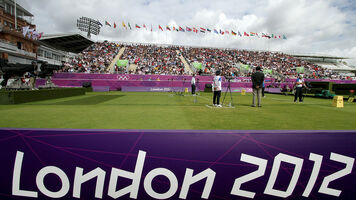This content is archived and as has not been processed. It may contain unformatted text or images, broken links or out-of-date information.
Archive
The Olympic History of Archery: From the 1900 Games in Paris to the 2008 Games in Beijing
Lausanne – 14 May 2012
The Olympic history of archery competition began at the 1900 Olympic Games in Paris. In order to fully enjoy the exciting 2012 London Olympic archery competition, we should glance back through history to observe how the rules of archery have evolved over the last 100 years.
The first archery competition at the Paris 1900 Olympic Games lasted 44 days and had an extensive programme: six individual and five team target events, two events for pole archery (popinjay) and six events for crossbow. From late May to August, the competitors began with the team competition and followed by the elimination round for the individual medal matches. In the crossbow competition, athletes either shot at regular targets or competed in the popinjay division. The popinjay competition was interesting: at the top of a pole there was a bird (plastic tube with feathers) that was part of the target. The popinjay competition had two competition formats of play in the Olympics. There were four target events of which one consisted at shooting on a target with a golden ring. The target events had a distance of 33 and 50 metres.
At the end of the Paris Olympic competition, four gold medals were awarded to the French team and two were bestowed upon the Belgian team. Henri HEROUIN (FRA) won the two competitions at 50 metres. Starting a brilliant Olympic career, Belgian archer Hubert VAN INNIS won two Olympic gold medals, at 30 metres, and one silver medal in Paris (plus one silver from an "international" competition). A special feature of the Paris Olympic Games was that the medal was rectangular. Ever since 1900, the medals have been round.
At the 1904 St. Louis Olympic Games, there were three divisions and the American competition rules were used. In the men’s competition, athletes competed in the Double York Round and Double American Round. There were four competition distances: 100, 80, 60, and 50 yards (100 yards are 91.44 metres). At each distance, archers were to shoot a unique number of arrows, ranging from 24 arrows to 72 arrows. The 1904 St. Louis Games were the first Games in which women competed in any sport, and archery was the first Olympic sport to admit women competitors.
The women shot in the Double Columbia and Double National Rounds. The Double Columbia Round was composed of three distances: 50, 40, and 30 yards. The Double National Round was shot at 50 and 60 yards. All of the medallists at the St. Louis Games were American. According to reports, it included Reverend Galen SPENCER from the Potomac Archers (Washington), who won the team gold at age 64, making him the oldest American to ever win an Olympic gold medal. Samuel DUVALL from the Cincinnati Archers also competed. At age 68, he won a team silver medal, setting a record as the oldest American to ever participate, or win a medal, in the Olympic Games.
At the 1908 London Olympics, the men’s events comprised of the Double York Round and the Continental Round. The women’s event was the Double National Round. The London competition was held on a dedicated archery venue for the first time. Two siblings, William and Charlotte DOD, won medals. Charlotte was a world class athlete in many sports at the time, including archery, field hockey, golf, ice skating and tennis, in which she won five Wimbledon titles (first one at age 15).
At the 1912 Olympic Games in Stockholm, archery was not on the Olympic programme.
The 1916 Berlin Olympic Games were not held because of World War I. The International Olympic Committee moved its headquarters to neutral Switzerland in 1915.
At the 1920 Antwerp Olympic Games, archery was readmitted to the Olympic programme. The competition consisted of 10 events of which there were four popinjay events. The popinjay competition was shot at 31 metres and at the top of the popinjay target there were two birds of different sizes. There were only six popinjay competitors. The target competition comprised of three individual events and three team events. Shooting distances were 28, 33, and 50 metres. At age 54, Hubert VAN INNIS returned to the Games, not only as an athlete but also helping the organisation. In Antwerp, he won two individual gold medals, one individual silver medal, two team gold medals, and one team silver medal. Overall, between Paris 1900 and Antwerp 1920, he won six gold and three silver Olympic medals, making him the most decorated athlete in archery Olympic history. To note, he later on competed at the first World Archery Championships in 1933 in London. At age 67, he finished 4th in the individual event, won the 50 metres competition and helped his Belgian compatriots win the team title! He competed in the world championships until 1936!
Antwerp marked the first time that there was head-to-head competition in the individual target events. An interesting piece of trivia from these Games was that the top target score was 9 points and the target had only nine rings.
After the Antwerp Olympic Games in 1920, archery no longer figured in the Olympic Games until 1972. The reason behind this absence was that there was no standardisation amongst international archery regulations. Different countries adopted their own rules and, as a result, the rules had to be amended for each Olympic Games. This led to the creation of the international federation in 1931: the Fédération Internationale de Tir à l'Arc (FITA). One of the reasons it took so long to be put back on the programme is that the International Archery Federation insisted on having a women’s competition.
After 50 years of FITA trying to make archery an Olympic sport, archery was re-introduced into Olympic competition at the 1972 Munich Olympic Games. The competition took place under Double FITA Round rules, whereby every competitor shot 288 arrows and the winner was determined by the highest total scores for men and women. There were only individual events. These regulations were used at all Olympic Games between 1972 in Munich and 1984 in Los Angeles.
At the 1988 Olympic Games in Seoul, the single FITA Qualification Round of 144 arrows was introduced. After the Qualification Round, the top 24 competitors continued and the top 8 shot the Medal Round. This type of competition was known as the Grand FITA Round. In 1988 the Games held team events, then there were four gold medals overall for archery.
The 1992 Barcelona Olympic Games welcomed the Olympic Round regulations, where, for the first time in Olympic history, archery featured exciting head-to-head competition and single elimination matches. Since the 1992 Olympic Games, basic competition rules have not changed significantly. Small amendments to the qualification and elimination rounds, such as the number of arrows, the shooting time limit, and the shooting sequence were incorporated into the individual events over the years. Team event rules also changed.
For the 2012 London Olympic Games, the individual archery rules have changed by adjusting the set point match. This new individual rule is exciting: the change often time keeps the suspense of the match until the end. The team competition rules, however, remain unchanged leading up to the 2012 Games. We anticipate that archery will be the most exciting sport of all at the London Olympic Games.
We should not forget the path that led us to where we are today. Although archery ceased being an Olympic sport for 50 years in the mid of the last century, it came back as ever strong featuring talented men and women, some winning Olympic medals at a very young age others making an incredibly long career.
Another special archery fact: the Olympic host nation has always won a gold medal except for Greece at the 2004 Athens Games since 1980. As the host nation for the 2012 Games Great Britain is for sure preparing a strong team to look for "their" gold medal.
World Archery is dedicated to making the sport as passionate and spectacular as possible and we are looking forward to another great archery showcase in one of the most extraordinary venue, the Lord’s Cricket Ground, that will become the Home of Archery during the London 2012 Olympic Games.
Host Nation Gold Medallists for Olympic Archery since 1980: Host City Gender Gold Medallist Nation Event 1980 Moscow Women Keto LOSABERIDZE URS Individual 1984 Los Angeles Men Darrell PACE USA Individual 1988 Seoul Men Women Women CHUN In-Soo, LEE Han-Sup, PARK Sung-Soo KIM Soo-Nyung, WANG Hee-Kyung, YUN Young-Sook KIM Soo-Nyung KOR KOR KOR Team Team Individual 1992 Barcelona Men Juan Carlos HOLGADO, Alfonso MENENDEZ, Antonio VAZQUEZ ESP Team 1996 Atlanta Men Men Justin HUISH, Butch JOHNSON, Rod WHITE Justin HUISH USA USA Team Individual 2000 Sydney Men Simon FAIRWEATHER AUS Individual 2008 Beijing Women ZHANG Juan Juan CHN Individual
KIM Soo Nyung
World Archery Communication










